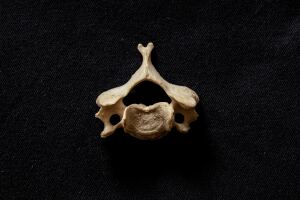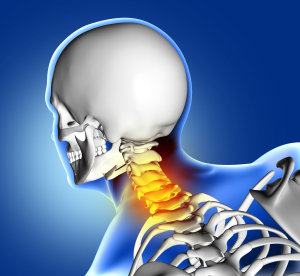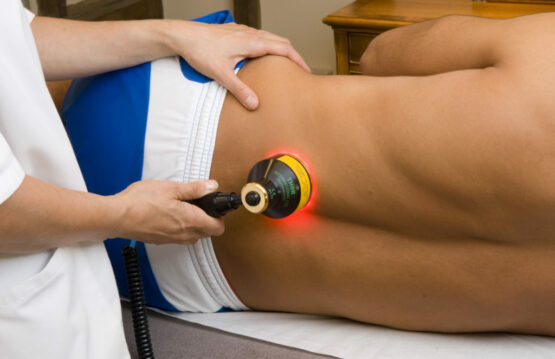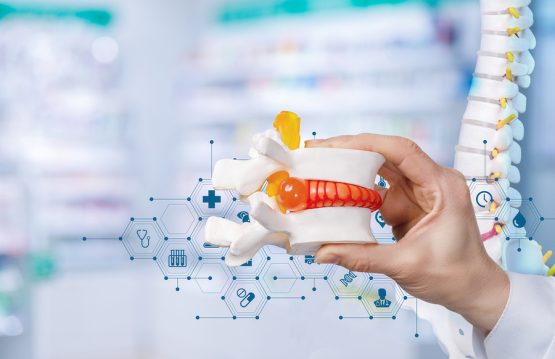In recent decades, laser therapy has become an increasingly common and effective option in treating cervical herniated discs. This non-invasive method has captured the attention of the medical community due to its ability to reduce pain, speed up the healing process and restore normal function of the cervical spine without requiring invasive surgery.
Cervical herniated disc is a painful and debilitating medical condition that affects the upper spine. This condition occurs when the gelatinous core of an intervertebral disc herniates or moves out of its normal position, putting pressure on the nerves or spinal cord in the neck area. Pain, tingling, muscle weakness, and other symptoms associated with cervical herniated discs can have a significant impact on patients’ quality of life.
CONTENT:
- How does laser therapy work in cervical herniated disc?
- Does laser therapy work for a pinched nerve in the neck?
- Benefits of laser therapy in cervical disc herniation
- Conclusion
How does laser therapy work in cervical herniated disc?
Laser treatment for the cervical spine is a form of non-invasive therapy that uses laser light to treat various conditions of the cervical spine. This therapy targets pain, inflammation, and promotes healing in herniated cervical discs, spondylosis, neck muscle or ligament injuries, arthritis, and similar neck-related conditions.
The laser treatment procedure for the cervical spine involves the use of a concentrated and focused laser light that can be applied directly to the affected area of the cervical spine. There are two main types of laser therapy used in the treatment of the cervical spine:

1. Low-energy laser (LLLT)
This type of laser therapy uses laser light at low intensities to influence healing processes and reduce inflammation and pain associated with cervical herniated discs. LLLT is non-invasive and is performed by applying a match-strength laser light to the affected area. It does not cause pain or discomfort to the patient and can stimulate the healing of damaged tissues by releasing chemicals in the body that promote healing processes.
2. High Intensity Laser (HILT)
Unlike LLLT, HILT uses the laser at higher intensities to penetrate deeper into the affected tissues. this allows the stimulation of healing processes at the cellular level. The high-intensity laser reaches deeper tissue layers and precisely targets the affected area, reducing inflammation, promoting healing, and alleviating pain linked with cervical herniated discs.
Both types of cervical herniated disc laser therapy have the main goal of stimulating healing and reducing symptoms such as pain, tingling or numbness, and muscle weakness associated with nerve compression in the cervical spine.
These techniques are frequently used as part of a complex treatment plan, which may include other medical interventions depending on the severity and particularity of a case. Moreover, it is important to emphasize that laser therapy for cervical herniation must be administered under the supervision and guidance of a medical specialist to ensure that it is applied correctly and safely, adapting to the specific needs of the patient.
Does laser therapy work for a pinched nerve in the neck?
Laser therapy can be beneficial for relieving symptoms associated with a pinched nerve in the neck area. Additionally, a neck pinched nerve can cause intense pain, numbness, tingling, or weakness in the arms, shoulders, and neck.
Laser therapy, including Low Energy Laser (LLLT) and High Intensity Laser (HILT), reduces inflammation, eases pain, and enhances healing around the affected nerve. This non-invasive treatment applies concentrated laser light to the affected area, expediting healing and reducing discomfort.
Low energy laser (LLLT) low intensities of laser light to stimulate healing processes in affected tissues. It can be helpful in reducing inflammation and pain without causing pain or discomfort.
High Intensity Laser (HILT) penetrates deeper tissues, stimulating cellular-level healing. Also, this laser therapy effectively reduces inflammation and neck nerve pain.

Benefits of laser therapy in cervical disc herniation
This therapy for cervical disc herniation offers notable benefits by alleviating symptoms, accelerating healing, and enhancing cervical spine function. Here is a more detailed development of the benefits of laser therapy in cervical disc herniation:
- Pain reduction
One of the most notable and desirable benefits of this therapy is its ability to reduce the pain. Moreover, laser therapy triggers endorphin release, easing pain in the treated area.
- Reducing inflammation
The laser with concentrated energy can direct to the affected area, aiding in the reduction of inflammation. This is crucial in treating cervical herniated discs, as excessive inflammation can worsen nerve compression and intensify pain. Reducing inflammation facilitates healing and can lessen the unpleasant symptoms associated with a herniated disc.
- Improving blood circulation
Laser therapy can improve blood circulation in the affected area of the cervical spine. Also, enhanced blood flow crucially aids healing by efficiently transporting nutrients and oxygen to affected tissues. This can speed up the recovery process and stimulate the regeneration of tissues affected by cervical disc herniation.
- Faster recovery
Laser therapy boosts natural healing, expediting recovery and reinstating cervical spine function. However, the laser can influence tissue regeneration mechanisms and support the body in its natural recovery and repair process.
Conclusion
This therapy in cervical disc herniation is a promising therapeutic option for those affected by this condition. However, qualified medical professionals must administer it and integrate it into a comprehensive treatment plan. Prioritize consulting a doctor or specialist before commencing any cervical herniated disc therapy for tailored and effective treatment.



